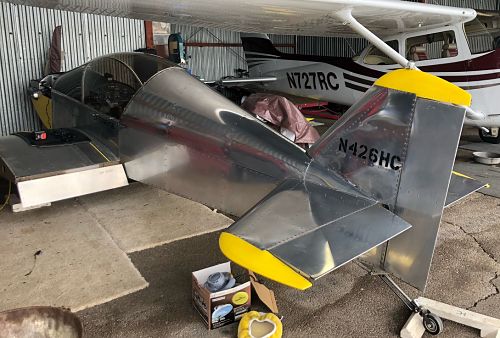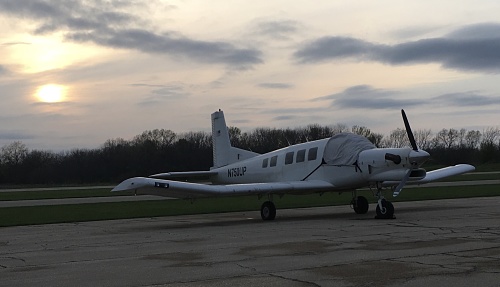The mid April breakfast was very well attended, and the food was prepared by Bob Pegg, Dave Stringer, Josh Mattson, and Jim Johnson. Volunteers are needed for the breakfasts ahead.
On the 8th, the chapter received word our Ray Scholarship nominee has been accepted by HQ:
Congratulations! We are very pleased to inform you that EAA Chapter 563 has been approved to administer Jolene Millerís Ray Aviation Scholarship to fund flight training for their Private pilot certificate. Due to previous flight training experiences, or lack thereof, the scholarship grant will total $10,000... In addition, the scholar will be eligible for a Lightspeed Zulu 3 headset... The first payout of $4,000 is in process.Jolene was introduced to the chapter at the April meeting, as was runner-up Logan Turner.
Chase Leason, a CAP cadet who recently turned 13, was also present at the chapter meeting. He'd just taken an airplane ride with Mt Hawley Aviation and had received a Fly3MY tee shirt. Chase will be moving to Mesa, AZ when the school year ends.
This month's VMC Club topic is maneuvering to avoid a mid-air collision, and the Club meets this Sunday in the hangar.
A related note comes from the newsletter of EAA chapter 59 in McGregor, TX regarding windsocks. Under FAA regulations, windsocks (also called wind cones) orient themselves to any breeze over 3 kt and will be fully extended at 15 kt. Several sources (including this one, which also gives a look at some older, patented wind flags and socks) say a segmented windsock, consisting of 5 segments of alternating colors, is designed to extend a segment for every 3 kt of wind, up to the 15 kt regulation. Oddly, over in Europe, the windsocks extend at 5 kt per segment, to a maximum of 25 kt.
The IMC Club meets the third Sunday this month, in the hangar.
HQ is offering a pair of week long passes to OSH, plus the use of a camper in Camp Scholler, to the winner of their "Pilot Your Own Adventure Contest." There are numerous other prizes, too. The theme of your brief story is to be "Tell us the true-life tale of your favorite aviation getaway." Entries must be between 500 and 1000 words and include at least three photos. They can be submitted electronically or by mail.
The chapter e-mail received a flier from the Women's Air and Space Museum in Cleveland describing a Titan T-51 they are selling. This airplane had been completed with builder assistance at the factory and then donated to the Museum. The airplane has a Honda V-6 for power and has not been flown yet. Contact the chapter secretary for a copy of the flier.
Welcome new member Corey Enderle:
I've been a pilot for a couple years. I have a Cherokee Six, but I'd like to find some co-owners to share expenses. I needed that big plane since I have five in my family, but as my kids get out of school perhaps I would downsize. In terms of experimental, I'd be interested in building a Zenith 701 or similar, or perhaps finding someone who wants to co-own theirs with me.
The Plouse's son Levi has also joined the chapter.
Greg LePine's Hose-Nose (F4U Corsair) has been been painted a dark blue. It's been given a matte finish by rollering water borne paint with a fine foam brush, aided by Floetrol conditioner. The engine needs to be timed before the first run up.

LePine's F4U painted
Not content with rollering one airplane, Greg volunteered to help Roy Paget paint his recently acquired 1941 J-3. A fresh coat of Army Green is covering the bird-stained Piper Yellow. Other volunteers included Andy Plouse and Karl Kleimenhagen on the painting and Ron Wright with fabric touch up. Young Chase Leason also helped with the rollering on the weekend. Roy and his wife Kim are giving this airplane to their son in the Carolinas, where he flies helicopters for the Army.

Chase helping start the paint job
Rich Gilbert has acquired a new toy, a Onex. He plans to install a larger engine and trailer the airplane with him on their travels around the country.

This month, Ron Wright writes about his experience in the building of four Monett Sonerai airplanes. The Sonerai was John Monett's first design released to the public, and he and Sonex have recently reacquired the rights to this VW powered design, one of the earliest designs offered for home building:
My first introduction to a Sonerai II-L (2 place, low wing, tail-dragger) experimental aircraft happened in the late '70's, while I was attending an air-show at Whiteside County Airport, where I first met Fred Keip, who was a Sonerai II-L builder and the editor of his own Sonerai news letter, a monthly publication depicting everything one would want to know about building and flying a Sonerai aircraft. Without Fred's detailed, informative, and precise monthly newsletters, I do not think that the Sonerai would have been as popular as it eventually became.
From that initial exposure, and after reading many back issues of Fred's newsletters, I looked for and acquired my first of four Sonerai II-L projects, about 40% completed, in the late '70's. Based on what I learned from that first project, and Fred's newsletters, I decided that I was "in way over my head" as I did not really know how to weld, overhaul a VW engine, or raise the canopy framing as I was way too tall for this Sonerai configuration! So, I decided to let this project find a new owner and look for another Sonerai project that was more complete than this one.

Ron in his first Sonerai
I did find and purchase two different Sonerai II-L projects. One of those I took to about the 95% complete stage, but it found a willing buyer who offered me a lot of money to acquire it. The third project was finished by me. Unfortunately—due to my not completing a very important change to the fuel system—on the initial flight around the pea patch, the engine stopped due to fuel starvation, and I had to put it into a mature bean field, which upon landing inverted me and the plane, doing enough damage to render it "totaled."
Finally, after a short recovery time for me, I decided to find and purchase a completely finished, flying, and proven Sonerai II-L, and learn how to fly it. The one I found had been built by a "professional" experimental aircraft builder, who was truly a talented and knowledgeable builder. He had flown his plane for over 200 hours, but due to a health condition was forced to end his flying days. This plane proved to be, in my opinion, the best built Sonerai II-L flying in the USA at that time.
I flew this plane for just under 2 years, accumulated about 90 hours on it, and came to appreciate how well constructed this plane was, based on the ability of the original builder.
It flew great. While the plane was not designed to be aerobatic, it was very sensitive to all control inputs. Cockpit visibility was great. Take-off and landing were flown at a slightly higher speed, so as not to stall it. While flying straight and level, if that was possible, one needed to fly this plane, or it would tend to wander off until one stopped day-dreaming, and concentrated on the flying of this great aircraft.
The only thing I would have done to this plane, had I decided to keep it long term, was to replace it's original 1835 cc Great Plains VW engine with their 2100 cc engine, and install an electric starter, to give this plane a bit more power and to eliminate the need to hand prop it.
As with my other, projects this plane eventually found a new owner and was transported to sunny California, a much more fitting environment than central Illinois.
Editors note: Monnett's later Sonex has similar characteristics but is all aluminum.

Air traffic controllers from PIA addressed the chapter at the April meeting. There is some concern that IFR traffic approaching PIA's runway 22 (say from Chicago) is a bit close to pattern altitude at 3MY. One proposal to increase separation is to reduce pattern altitude to 800' AGL from 1000', and another is making the pattern right traffic to 18 while maintaining left traffic on 36. Neither proposal was popular with the pilots present. Pilots preparing to depart 3MY can contact PIA on 121.6 to let them know their intentions.
There was a unique visitor to the field in late April, a Pacific Aerospace P-750 manufactured in New Zealand. The wing is unusual and is similar to the homebuilt Thorp T-18 in having a rectangular planform wing with the dihedral break near mid span. The Jodel series of homebuilts from France also use such a dihedral break, but have tapered outer sections.

The Grumman Avenger annual fly-in at Peru, IL is on again this year. This is one of the best local fly-ins each year and well worth the modest drive.